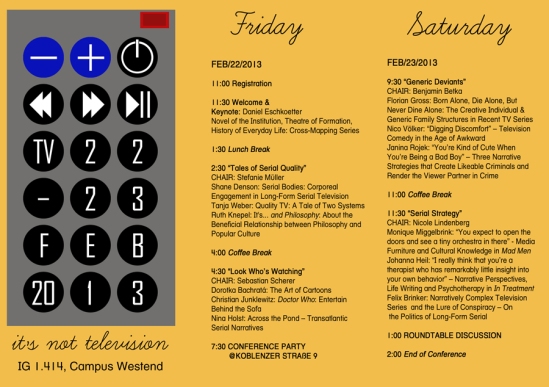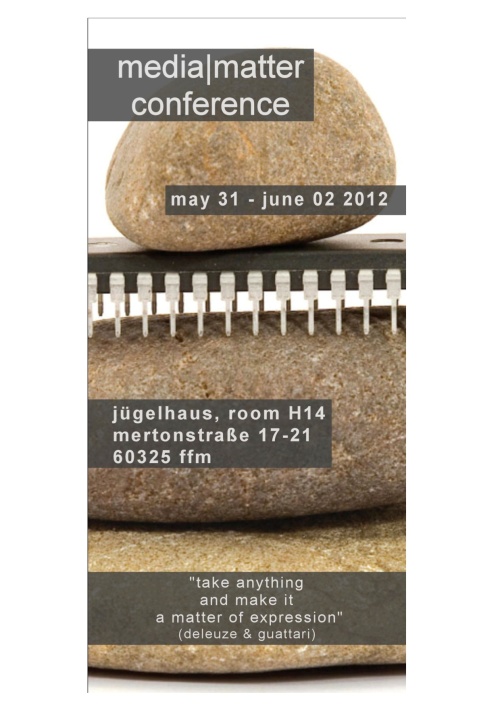The video of my Mercator Lecture for the Configurations of Film Graduiertenkolleg at the Goethe-Universität Frankfurt, “Post-Cinematic Bodies” (from November 23, 2020), is now online. Hope you enjoy!
Tag: Frankfurt
Post-Cinematic Bodies — Mercator Fellow Lecture, Nov. 23, 2020

I am excited to be serving as the current Mercator Fellow at the Konfigurationen des Films Graduiertenkolleg / Configurations of Film Graduate Program at the Goethe Universität in Frankfurt — via Zoom, of course — and to deliver a talk titled “Post-Cinematic Bodies” on November 23, 2020 (6pm European time). More info about the event can be found here, with registration details coming soon.
It’s Not TV: Conference Program
Above, the program for the conference “It’s Not Television” in Frankfurt, where Florian Groß, Felix Brinker, and I will be presenting this coming week. (More about our talks — and links to our abstracts — here.)
It’s Not Television (Or Is It?)
Three members of the Initiative for Interdisciplinary Media Research (Felix Brinker, Florian Groß, and Shane Denson) will be presenting papers at the upcoming conference “It’s Not Television” (22-23 February 2013, Goethe University of Frankfurt). Our abstracts can be found here:
Shane Denson: “Serial Bodies: Corporeal Engagement in Long-Form Serial Television”
Felix Brinker: “On the Politics of Long-Form Serial Storytelling and the Paranoid Eye of Active Audiences”
Abstract for Felix Brinker’s talk at the conference “It’s Not Television” (Frankfurt, 22-23 February 2013). See here for talks by other members of the Initiative for Interdisciplinary Media Research.
Narratively Complex Television Series and the Lure of Conspiracy – On the Politics of Long-Form Serial Storytelling and the Paranoid Eye of Active Audiences
Felix Brinker
The threat of conspiracy looms large in a striking number of recent American television series. From the efforts of 24’s and Homeland’s protagonists to stop terrorists, to the nefarious government conspiracies on Last Resort, Rubicon, and Prison Break, and the shadowy cabals plotting on Lost, Fringe, and Battlestar Galactica: television narratives about secret plots against the reigning order of things appear to be well suited to capture the imagination of contemporary audiences in the US and elsewhere. While the engagement with this theme lends itself to politicized readings, the motif of conspiracy is also part and parcel of a robust narrative structure that enables the unfolding of complex storylines. In this respect, ‘conspiracy’ denotes not just a thematic preoccupation but also an organizational logic that allows these shows to tell long-running stories about investigations, cover-ups, and mysteries whose resolutions are perpetually deferred. As detective stories of a grand scope, these shows keep viewers hooked by juggling the appeals of suspense and mystery, by countering each revelation with a plot twist tailored to sustain audience interest.
My paper will sketch the basic parameters of this mode of storytelling and discuss the audience practices it inspires. I argue that, in order to perform within the competitive media environment of the convergence age, said shows rely on the structure of conspiracy to encourage audiences to carefully comb through their narrative material in search of hidden clues about the plots’ mysteries. By doing so, they ask viewers to rely on an interpretive logic that parallels the paranoid hermeneutics of conspiracy theorists: analysis and interpretation of transmedial story-worlds can thus become a pleasurable, associative, and open-ended activity that allows the viewer to assert her authority over the (shifting) overall meanings of (the) (hi)story. The political significance of these shows therefore lies less in their overt content, but rather manifests itself on the level of storytelling strategies and the audience practices enabled by the latter.
Shane Denson: “Corporeal Engagement in Long-Form Serial Television”
Abstract for Shane Denson’s talk at the conference “It’s Not Television” (Frankfurt, 22-23 February 2013). See here for talks by other members of the Initiative for Interdisciplinary Media Research.
Serial Bodies: Corporeal Engagement in Long-Form Serial Television
Shane Denson
Discussions of so-called “Quality TV” and the narrative complexity seen to characterize the best of contemporary serial television productions often trade on categories of distinction derived from comparisons with “respectable” cultural forms (e.g. the novel as a model for “serious” engagement); these discourses value an intellectually demanding, heady sort of appeal that is opposed both to the narrative simplicity supposedly characteristic of older televisual forms (strictly episodic forms, melodramatic soap operas, etc.) and to the baser appeals of contemporary “trash TV” (e.g. the basically voyeuristic interest encouraged by reality TV). Interestingly, though, graphic scenes of sex and violence proliferate across contemporary television series, including shows widely valued for their cognitive demands; today, bodies are put on display, violated, tortured, dissected, and ripped apart in ways unimaginable on TV screens just a decade ago. In this presentation, I argue that these body spectacles – which range from clinical/forensic to brutal/gory to pornographic – challenge us to rethink the basis of television studies’ formal and normative distinctions. In particular, the complex mental operations valued as correlates of narratological complexity must be seen to take place side by side with a range of more corporeal responses on the part of television viewers. Finally, I propose an alternative view of televisual complexity and serialization: appealing to the body as much as the head, contemporary television will be shown to involve a serialization of bodies (both onscreen and off) that constitutes a central affective mechanism for engaging viewers week after week in long-form serial television.
Florian Groß: “The Creative Individual and Generic Family Structures in Recent TV Series”
Abstract for Florian Groß’s talk at the conference “It’s Not Television” (Frankfurt, 22-23 February 2013). See here for talks by other members of the Initiative for Interdisciplinary Media Research.
Born Alone, Die Alone, But Never Dine Alone:
The Creative Individual and Generic Family Structures in Recent TV SeriesFlorian Groß
Ever since television has been part of the American family, the American family has been part of television. Even under the “not TV”-paradigm, family remains a central aspect of television, as shows like The Sopranos or Six Feet Under attest. In many recent shows, this constitutive part of the televisual landscape interacts with a highly fetishized figure in contemporary television, the creative individual. Californication’s Hank Moody, Mad Men’s Don Draper, or 30 Rock’s Liz Lemon are but a few examples of non-conformist, iconoclast and ingenious characters who express their innate urges in various aesthetic(ized) fields and serially assert their individual freedom and self-reliance. Yet, despite their superficial undermining of traditional (family) concepts, they also take serial recourse to standard conceptions of family. They may be adulterers, divorcees, or singles, but they hardly ever define themselves without the (white, middle class, nuclear) family, which emerges as a structure that provides the creative heroes with boundaries that prevents them from becoming antisocial.
My paper analyzes this dynamic interaction between an aestheticized individualism and the continued relevance of family structures. Furthermore, I want to link this narrative aspect of television series to their respective take on genres. In an era that is purportedly moving beyond genre, it becomes nevertheless apparent that series frequently resort to classic televisual genres and thus return to their generic ‘family’. In the end, looking at recent television’s simultaneous deconstruction and reconstruction of the American family helps to explain how and why today’s segmented audience(s) are symbolically (re-)united by forms of television that restore the social function of an “electronic hearth” (Tichi).
“Take anything and make it a matter of expression”: media | matter conference
media|matter:
the matter of media | the mediality of matter
Here’s the announcement I just received from Bernd Herzogenrath for an exciting conference coming up soon (May 31 – June 2, 2012) in Frankfurt. Be sure to click the link above for the conference program, list of speakers (including Bill Morrison, Thomas Köner, Lorenz Engell, and Hanjo Berressem), registration, and other info.
The 2012 media|matter conference reflects the increased interest in the material aspects of our culture, triggered by the material turn as postulated by Deleuze & Guattari, Varela & Maturana, Serres, and others. In consequence we will assess the implications of this blossoming field of research which focuses rather on what represents, than on what is represented.The aim of our conference is to re-focus approaches in culture- and media-sciences and to open up and foster new, interdisciplinary perspectives and concepts towards a revised understanding of media. By highlighting the materiality of the medium and reading this very materiality as medium, questions occur: can content and form still be regarded as separate? Or shouldn’t we rather acknowledge that the matter of the medium affects the message that is conveyed and represented? Shouldn’t we consequently speak of informed matter and of materialized information?In the same way, social- and cultural-sciences cannot ignore the findings of the life-sciences, especially in the fields of complexity-theory and non-linear systems. Thus this conference also intends to bring together artists and researchers from diverse disciplines with differing understandings of media and materiality, not only to create feedback-loops between natural- and cultural-sciences, but also to re-think the somewhat fuzzy concepts of nature and culture.





